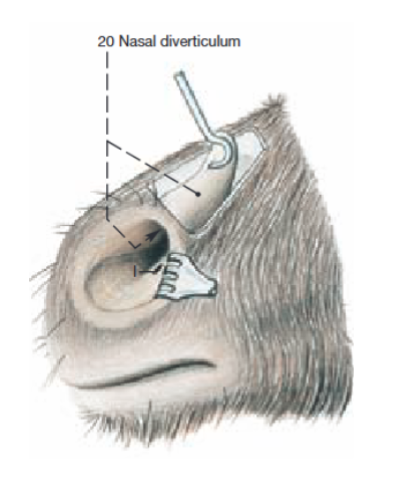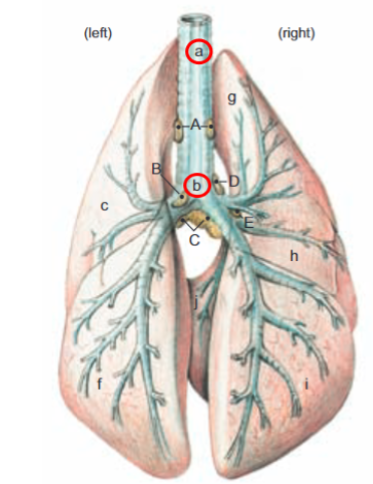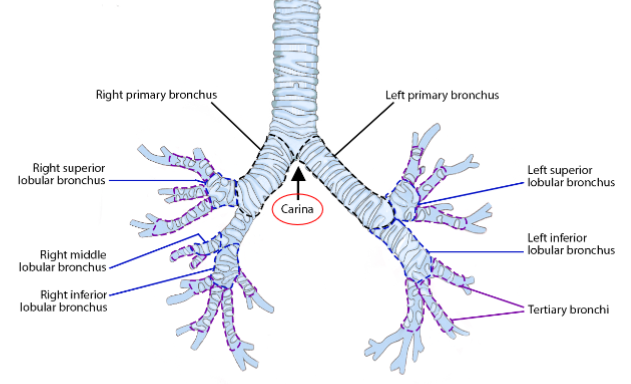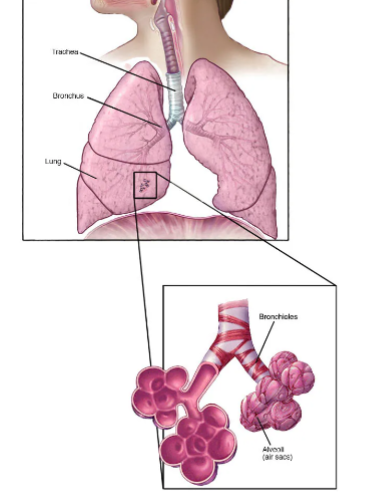The Respiratory System
1/90
Earn XP
Description and Tags
ANSC 309
Name | Mastery | Learn | Test | Matching | Spaced |
|---|
No study sessions yet.
91 Terms
what is the function of the respiratory system?
to move inspired air containing oxygen along the respiratory passages to the areas where gaseous exchange takes place and to move expired air containing carbon dioxide out of the body
what is the name for the areas where gaseous exchange takes place?
alveoli
what structures does the respiratory system consist of?
nose and naval cavity
pharynx
nasopharynx
larynx
trachea
lungs
primary (mainstem) bronchi
lobar bronchi
bronchioles
alveoli
the nose comprises the:
external nose
nasal cavities (paired)
paranasal sinuses (paired)
what are different factors of the nose that differ between certain species?
form and size of nostrils, their orientation. and the nature of the surrounding integument
what is another name for nostrils?
nares
what are nares?
hairless and well demarcated from the skin of the face (with exception of the horse)
plate/planum
the region of skin around the nares
why is the plate moist to the touch?
because of the secretions of the underlying glands
the nasal plate of the dog and cat is divided by a median groove called the…
philtrum
depending on the species, the naming for the piece of skin around the ______ is different.
nares
what is the skin around the nares called in carnivores and small ruminants?
nasal plate/planum nasale
what is the piece of skin around the nares in cattle called?
nasolabial plate/planum nasolabiale
what is the piece of skin around the nares called in pigs?
rostral plate
horses have a blind sac of the nose called _______ _________
nasal diverticulum

what is the main function of nasal cartilage?
to support and shape the external nose
what is the function of alar cartilage?
(attached to the free edges of the septum) support the dorsal and lateral margins, and determine the form of the opening of the nostrils
what creates the right and left nasal cavities?
the rostral part of the nasal septum
the skin of the external nose meets with the _____ ________ in the ______ ________ at a sharply defined line
nasal mucosa; nasal vestibule
at the sharply defined line, in what animal is the orifice of the nasolacrimal duct on the vestibule floor?
horse
the sharply defined line opening is less easily found in other species. list 2 reasons why?
because the tissues are less pliant (cattle)
because it is placed more deeply (dog)
list the functions of the nasal cavity
warms the air passing over the highly vascular mucosa
humidifies the air by the vapors of tears and serous nasal secretions
cleans the air of particles by interacting with the mucus
describe the makeup of the nasal septum
largely cartilaginous but is ossified in its most caudal part
conchae
on either side of the nasal septum and are scroll-like bones
what are the names of the spaces surrounding the dorsal and ventral conchae?
dorsal meatus
middle meatus
ventral meatus
common meatus
the ventral and common meatuses provide the principle airway leading to the ________
pharynx
what is the clinical relevance of the ventral and common meatuses leading to the pharynx?
a nasogastric tube passes through the wide space at the junction of the ventral and common meatuses
the paranasal sinuses are the ________ of the nasal cavoty
diverticula
how are paranasal sinuses developed?
postnatally by the separation of inner and outer tables of the skull bones
all species have what 2 sinus systems?
frontal and maxillary sinus systems
what structure forms the connection between the pharynx and the trachea?
larynx (it lies below the pharynx and behind the mouth)
what are the major, consistently present cartilages of the larynx?
epiglottic cartilage
thyroid cartilage
cricoid cartilage
arytenoid cartilages (paired)
what laryngeal cartilage is most rostral and covers the entrance of the larynx when the animal swallows?
epiglottic cartilage
describe the appearance of epiglottic cartilage
consists of a small stalk and a large leaflike blade
what laryngeal cartilage is the largest?
thyroid cartilage
what does thyroid cartilage consist of?
two lateral plates that fuse to a varying degree ventrally and form a major part of the laryngeal floor
describe the appearance of the cricoid cartilage
it is fashioned like a signet ring, consisting of an expanded dorsal “seal” and a narrower ventral arch
describe the appearance of arytenoid cartilage
paired and have a very irregular form best described as pyramidal
what is used to intubate an animal through the larynx?
endotracheal tube
steps of intubating with an endotracheal tube
use laryngoscope
use sterile lubricant
avoid inserting too far (entering the carina or mainstem bronchi)
what two structures form a continuous system of tubes conducting air between the larynx and the smaller passages in the lungs?
trachea and bronchi
together, the trachea and bronchi are sometimes termed…
tracheobronchial tree
describe the location of the trachea
the trachea leads from the larynx through the neck, enters the mediastinum at the thoracic inlet, and continues to its terminal bifurcation dorsal to the heart
where does the bifurcation lie?
in the region of the fourth to sixth intercostal spaces
the two mainstem bronchi diverge from the ….. to quickly enter the corresponding lungs at their roots
line of the trachea

carina
the tracheal bifurcation which divides the left and right mainstem bronchi

in what animal(s) is there a separate tracheal bronchus that arises proximal to the tracheal bifurcation to enter the cranial lobe of the right lung?
in ruminants and pigs
what is the wall of the trachea composed of?
inner mucosa
middle cartilaginous layer
outer adventitia (in the neck) or serosa (in the thorax)
in the trachea, the cartilaginous coat is composed of numerous strips of cartilage that are bent to form ________, that are incomplete dorsally
rings
what is the function of the cartilage rings?
to help prevent collapse of the trachea
what are the edges of the strips of the tracheal cartilaginous rings connected to each other by?
sheets of rather elastic connective tissue
the smooth tracheal muscle bridges the gap within the ring in most species, but is placed externally in what anima
collapsing trachea
a relatively common disorder of the trachea resulting from weakened cartilage of the tracheal rings in canines
common clinical signs of collapsing trachea?
persistent, dry, harsh cough (goose honk)
cough may worsen with excitement, with pressure on the trachea, such as from a collar, during hot or humid weather, or immediately after eating or drinking
the structure of the larger bronchi is identical to that of the ________
trachea
with further divisions of the bronchi, the cartilage rings are gradually replaced by irregular plaques, and they finally disappear to mark the transition into __________
bronchioles

pleura
serous membranes that cover the lungs and line the walls of the thorax
the pleura forms the left and right sacs that enclose the …
pleural cavities (each consist of visceral and parietal parts, depending on their location)
mediastinum
the median partition in the thorax within which the heart and other thoracic organs are situated (space between the right and left sacs)
visceral/pulmonary plura
the part of the pleura that clothes the lung directly
the pulmonary pleura is reflected around, and behind, the root of the lung to become continuous with the ________ _______
mediastinal plura
the mediastinal pleura is continuous with the ______ and _________ pleura
costal and diaphragmatic
the mediastinal, costal, and diaphragmatic pleura together are called the …
parietal pleura
the right and left lungs are enclosed into their respective pleural sacs and are free except at the _______
roots
what are the roots of the lungs attached to?
the mediastinum
what do lungs do when squeezed and when placed in water? why?
crepitate (make a crackling sound) when squeezed
float when placed in water
they do this because of their soft, spongy texture, and they have residual air in them, even when collapsed
which lung is always larger?
right lung
what are the features of each lung?
an apex toward the thoracic inlet
a wide, concave base facing the diaphragm
a convex costal surface fitted against the lateral chest wall
the ventral part is indented over the heart (cardiac notch)
how is the root of the lung formed?
by the bunching together of the mainstem bronchus and the pulmonary artery, veins, lymphatics, and nerve
where does the root of the lung sit comparatively to the heart?
sits dorsal to the heart
what is the clinical relevance of the heart being directly beneath the bronchi?
cardiomegaly — enlarged heart compresses the trachea and bronchi against the dorsal thoracic wall resulting in coughing
what are the lobes of the left lung?
cranial lobe
cranial part
caudal part
caudal lobe
what are the lobes of the right lung?
cranial lobe
middle lobe
horse lacks middle lobe
caudal lobe
accessory lobe
in most species one or more ________ extend into the substance toward the root, dividing each lung into parts
fissures
when are fissure lines clinically relevant?
when assessing the chest cavity for pleural fluid in the thoracic cavity
what is the identification of lungs of individual species most conveniently based on?
the degrees of lobation and lobulation
describe the degree of lobation in horses
show almost no lobation and very inconspicuous lobulation externally
describe the degree of lobation in ruminants and pigs
conspicuously lobated and lobulated
describe the degree of lobation in carnivores
very deeply fissured into lobes but show little external evidence of lobulation
bronchiole
narrow — less than 1 mm in diameter — and pass through several generations
where do the bronchioles terminate at?
alveoli
(true/false) the alveoli is the only place where gaseous exchange takes place
true
how is carbon dioxide formed in the body before expired?
formed by the tissues during metabolism